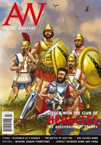|
|

The Theban Hegemony was a brief ten year period in which the Boeotian city of Thebes dominated ancient Greece, invading the Peloponnese, and permanently turning Sparta from a Greek power into at best a local Peloponnesean power. This dramatic decade began with the Theban victory over the Spartans at Leuctra in 371 BC, and effectively ended with the death of their inspirational leader Epaminondas at Mantinea in 362 BC, just as he was on the verge of another crushing victory over the Spartans. This issue of Ancient Warfare focuses on that ten year period, and the impact it had on Ancient Greece.
Three of the articles directly address the Thebans – a look at Epaminondas, their most successful military leader, a history of the famous Theban Sacred Band, looking at its origins, the way it was used, and its eventual fate, and a discussion of the key battle of Leuctra, an apparently simple battle, but with one big mystery – exactly what did the Sacred Band do? The author has come up with a plausible suggestion for their role, putting them in the front row of the Theban phalanx, with the aim of decapitating the Spartan leadership as quickly as possible, but does also mention the other alternative (including their use as a separate unit, or their use to form several complete files within the deep phalanx). There is also a useful look at Plutarch's reliability, important for this period as his biographies of several key figures add details to our picture of the period, a look at the time Philip II spent in Thebes, and an account of the Siege of Corcyra, one of the battles of the Boeotian War that involved the Athenians, then fighting as allies of Thebes.
I would quibble a little with the article on the education of Philip II of Macedon in Thebes. The article portrays this as a straightforward piece of history, but that isn't the case. We aren't really sure when Philip was sent to Thebes, who sent him (or took him hostage), why he went, or when he returned homes, with our sources giving contradictory accounts. The same is true about what he did while in Thebes, and there are problems with the accounts of him receiving a military education in the city.
Away from the theme there was a useful article on the possible connections between China and India, acting as a balance to the current tendency to assume that there were some direct connections. Here the author may have gone too far the other way but he does remind us how thin the sources are. There is also a look at Roman military tombstones, a useful source of information about the careers of lower ranking soldiers.
Articles
The Theban ascendancy - Historical introduction
Plutarch of Chaeronea - The biographer and the moralist
First amongst the Greeks - Epaminondas
The reenactor - At the dawn of Theban Hegemony
The Siege of Corcyra - Spartan eclipse
Educating Philip of Macedon - Sowing the seeds of destruction
On the dancing floor of Ares - The Battle of Leuctra
The Theban Sacred Band - A chosen few
Special Features
Roman military tombstones - From the spirits of the departed
Rome and China - Did Rome have links with the Far East?
Hollywood Romans - Caesar and Cleopatra (1945)
Go to Ancient Warfare Magazine Website